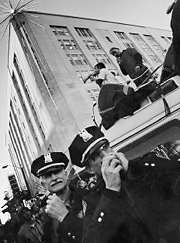IT’S ONE OF the mysteries of the World Trade Organization riots: Why didn’t police raid the commandeered Virginia Street building of anarchists and roust the 150 infamous squatters thought to be most responsible for WTO street violence?
The reason given by the top Seattle cop in charge of WTO security isn’t too reassuring. Former Seattle Assistant Police Chief Ed Joiner says that though he had given the go-ahead to plan an assault on the building, 1) it didn’t come until the third day of the November 30-December 3 conference, 2) his officers were too fatigued and preoccupied with demonstrations to force an entry, and 3) SPD commanders shifted responsibility for an entry back and forth for two more days. Then a new problem cropped up: Was the building booby-trapped?
“We had a discussion on Saturday morning [December 4]. In fact, there was serious consideration about making a forced entry,” Joiner recently told the city’s WTO Accountability Review Committee, regarding the anarchists’ week-long takeover of the unoccupied upper two floors at Ninth and Virginia. But “based on [intelligence] information we had, that it had possibly been booby-trapped, that they had spread gasoline on it, that the place could go up like a torch,” the assault was never made. The anarchists pulled out within the next few days.
Police critics such as Los Angeles County Sheriff’s official Richard Odenthal, who pitched in as an SPD consultant during the riots, said the site was a secure staging area for the anarchists’ sophisticated trash-and-run tactics and provided a rooftop observatory of police operations.
But Joiner said reports of the supposed “nest of anarchists” were exaggerated. No one in the building had been “identified as [a] criminal from downtown” rioting and thus an entry wasn’t a priority.
In a lengthy question-and-answer session May 18 with the review committee’s director, Alec Fisken, Joiner also indicated Seattle had little notion of what it was getting into when Port of Seattle, congressional, and city officials enthusiastically wooed and won the WTO ministerial conference, hoping to showcase Seattle as a world-class city (ironically, resulting instead in a world-class civic shiner).
Joiner said the SPD originally planned to put no more than 100 cops on the street for WTO security. That proposed deployment doubled to 200 after police learned of violent anti-WTO demonstrations in Europe last summer. By opening day, November 30, the number had doubled again to 400 officers as more intelligence reports and Internet chat raised security concerns. “If the situation became problematic for us,” Joiner told Fisken, SPD’s mutual aid plan was to call in more city officers from beats, have the county sheriff’s office take over city 911 response calls, and use suburban cops to help the county cover its beats. (After a state of emergency was declared, the street force was swiftly augmented by almost 600 local and state officers, plus the National Guard.)
“Until Tuesday morning,” Joiner noted, “I continued to feel confident that we had the resources available to deal with the crowd control situation . . . I did not anticipate not being able to handle it with what we had.”
He insisted lack of funding didn’t truly affect his deployment plan, which was predicated on events going smoothly. “I really felt that if things went well, if things went peacefully, that reimbursement [for a larger but unnecessary force] was going to be a real [budget] issue. My own judgment was that [if] things really . . . turned out to be a mess, that in all likelihood we’d have less problem getting reimbursement because people would recognize that this was a massive event . . . and so there would be more of a willingness to chip in from the federal government’s side. Of course, as it’s turning out, I don’t know that that’s the case.” The federal government has yet to chip in substantially.
Joiner said that even if he’d been given as much as $15 million in advance—a figure Fisken tossed out for conjecture—he wouldn’t have initially fielded a much larger force because of, again, the underestimated threat assessment. When as many as 50,000 demonstrators showed up, SPD’s security strategy went out the window and, most critically, Joiner said, a 20-member SPD Flying Squad intended to target anarchistic street violence had to be deployed elsewhere.
“During the event, while we’re in the middle of it,” Joiner recalled, describing a conversation with an intelligence planner, “I said ‘Did anyone ever anticipate this?’ And the answer was, ‘No.”‘
His statements add another piece to the WTO puzzle being assembled by the City Council’s reviewers, who should be winding up their five-month study by the end of July. A final report will follow, supposedly naming names and placing blame for the event that did millions in damage and left local governments with a $12 million tab.
Joiner placed some blame on nonviolent demonstrators who, he said, had made a deal with the city and then failed to keep their end of it. “That was one of the most disappointing facets of the whole event,” he said. “It wasn’t a matter of several hundred problem children [anarchists and other street vandals] that we knew were going to be there, and were [there]. It was the thousands of local protesters who did things [like blocking streets and passageways] that prevented us from effectively dealing with the problem ones . . . It certainly complicated our lives immensely.”
Though now-retired Police Chief Norm Stamper has been criticized as a “no-show” during the WTO, Joiner defended Stamper’s low-profile: “He was kept up to speed, and I would say that’s consistent with what’s done in a vast majority of agencies. . . .For someone to say the chief should have been there would be the same as saying the general should be putting all the [war] plans together.”
Visit our special coverage section on the WTO.








